Hisense Electric LCDF0096 LED LCD TV User Manual TempConfidential W9HLCDF0096 2
Hisense Electric Co., Ltd. LED LCD TV TempConfidential W9HLCDF0096 2
Contents
- 1. TempConfidential_W9HLCDF0096_User Manual 1
- 2. TempConfidential_W9HLCDF0096_User Manual 2
- 3. TempConfidential_W9HLCDF0096_User Manual 3
- 4. TempConfidential_W9HLCDF0096_User Manual 4
- 5. TempConfidential_W9HLCDF0096_User Manual 5
TempConfidential_W9HLCDF0096_User Manual 2
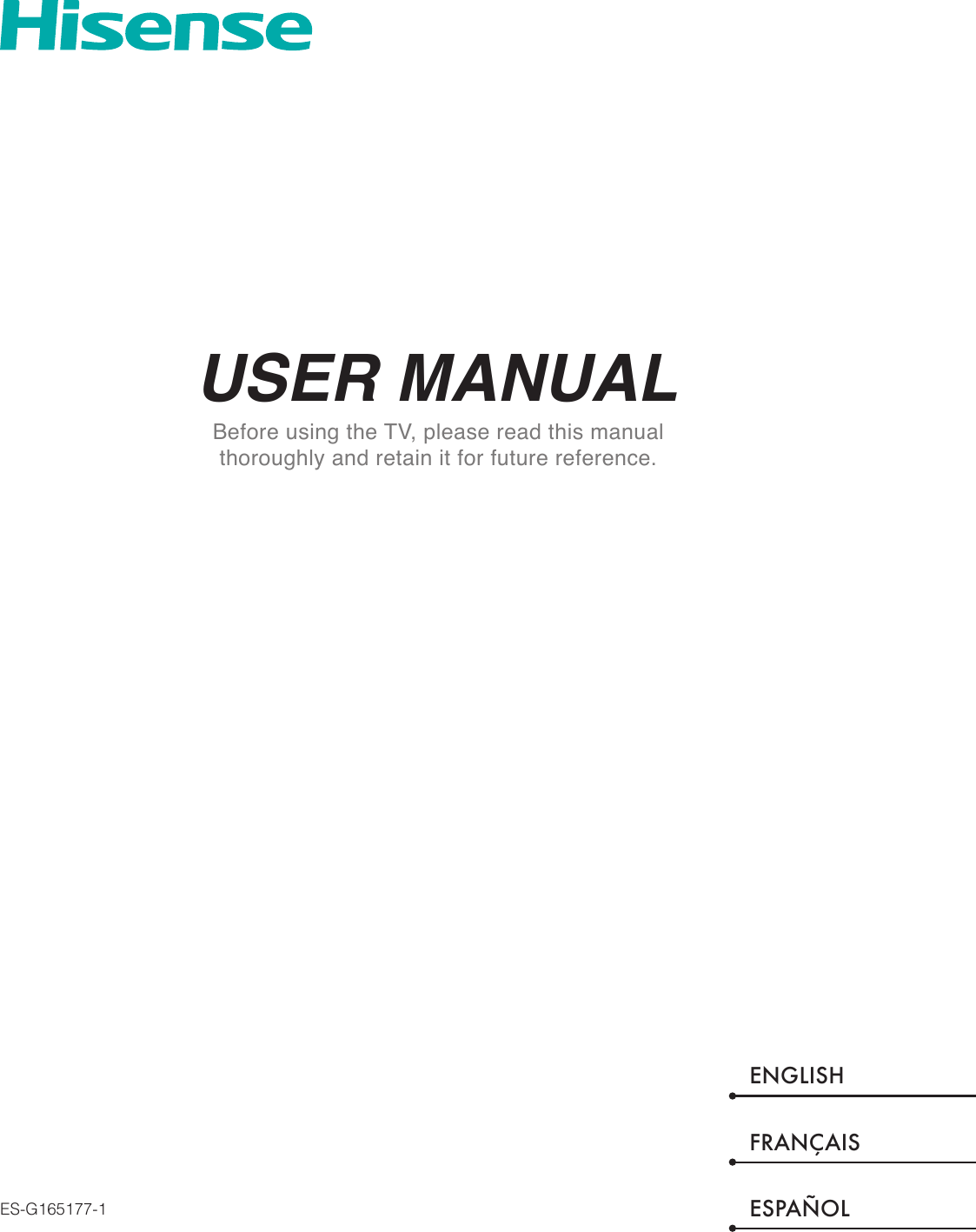



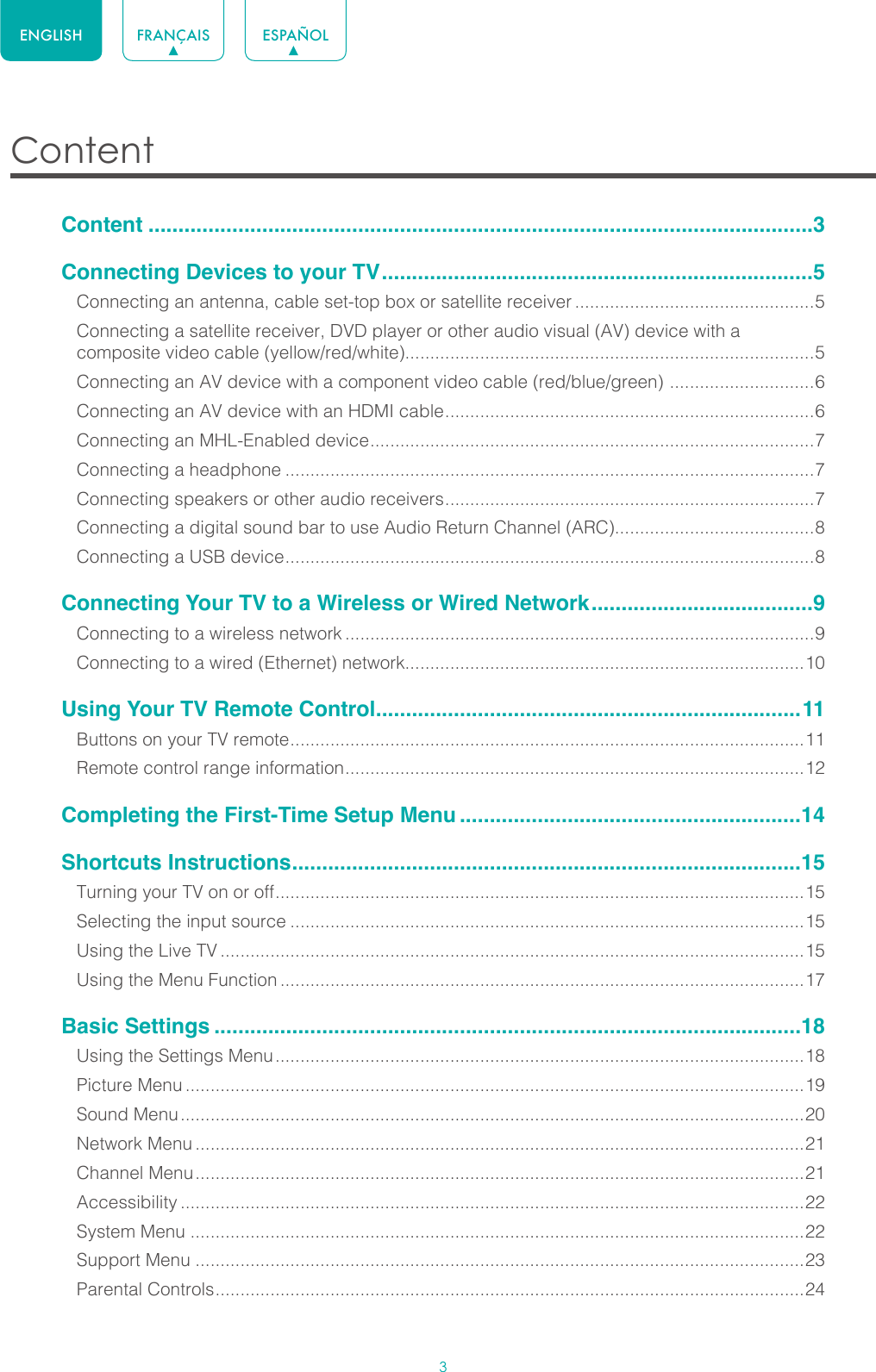

![5ENGLISH FRANÇAIS ESPAÑOLConnecting Devices to your TV You have several options for connecting your TV to different devices. The method in which you connect will be based upon the type of cables you have and the available outputs on your device.Connecting an antenna, cable set-top box or satellite receiverTo connect an antenna,cable set-top box or satellite receiver: 1. Connect one end of a coaxial cable (not included) to the RF OUT port on the antenna, cable or satellite box. If you are using an antenna with twin-lead cable, you may need a 300-75 Ohm adapter (not provided) to connect it to the back of your TV. Likewise, if you are using several antennas, you may need a combiner (not provided).2. Connect the other end of the cable to the ANT/CABLE port on the side of TV.3. Using your remote, press the [INPUT] button and select ANT/CABLE as the input source. Connecting a satellite receiver, DVD player or other audio visual (AV) device with a composite video cable (yellow/red/white)To connect an AV device with a composite video cable (not provided):1. Use the audio and video cables to connect the composite video/audio ports of the external AV device to the AV IN ports of the TV. (Video = yellow, Audio Left = white, and Audio Right = red)2. Plug the connected devices into the AV connectors on the TV before switching it on.3. Using your remote, press the [INPUT] button and select AV as the input source.or ANT OUTCable Set top boxRF OutEXTERNAL DEVICETV PORTANT/CABLEAV OUTVideoLRWhite (L)White (L)Yellow (Video)Yellow or Green (Video)Video CableRed (R)Red (R)Audio Cable TV PORTSEXTERNAL DEVICESDVD Player/RecorderVideo Camera Set-top boxSatellite ReceiverSatellite antenna cableVCRVIDEOL RAV IN](https://usermanual.wiki/Hisense-Electric/LCDF0096.TempConfidential-W9HLCDF0096-User-Manual-2/User-Guide-3279491-Page-7.png)
![6ENGLISH FRANÇAIS ESPAÑOLConnecting an AV device with a component video cable (red/blue/green) To connect an AV device with a component cable (not provided):1. Use a component video cable to connect the component output ports of the external device to the YPBPR ports for the TV. (Y = green, PB = blue, and PR = red). Use an audio cable to connect the component audio ports of the external device to the TV AUDIO (L/R) ports. 2. Plug the connected devices into the YPBPR and L/R ports on the TV before switching it on.3. Using your remote, press the [INPUT] button and select COMPONENT as the input source.NOTE• One AV device can be connected to the TV using a component video or composite video cable.Connecting an AV device with an HDMI cableThis 4K TV has two different software versions of HDMI ports to connect HDMI-enabled devices. The two high-powered HDMI version 2.0 inputs enable you to connect 4K Ultra-HD external devices that require more bandwidth to transmit to the TV screen. For example, if you have an X-box or Blu-ray player that supports the 2.0 standard. The two HDMI version 1.4 inputs are great for any of your external devices that support a standard full high-definition resolution of 1080p.Please refer to the User Manual that came with your device for step-by-step instructions.To connect an AV device with an HDMI cable (not provided):1. Use an HDMI cable to connect the HDMI output port of the AV device to the HDMI port of the TV.2. Plug the connected devices into the HDMI port on the TV before switching it on.3. Using your remote, press the [INPUT] button and select the corresponding HDMI input. NOTES• Because the HDMI connector provides video and audio signals, it is not necessary to connect an audio cable.• We strongly recommend to use HDMI Cable with 2 cores as shown in the figure.EXTERNAL DEVICESDVD Player/RecorderVideo Camera Set-top boxSatellite ReceiverSatellite antenna cableVCRWhite(L) White(L)Red(R) Red(R)Audio Cable Component Cable ComponentRLPRPBYRed(PR/CR)Red(PR/CR)Blue(PB/CB)Blue(PB/CB)Green(Y) Green(Y)TV PORTSAV INCOMPONENT INVIDEO LYPBPRRHDMIHDMIEXTERNAL DEVICESDVDSet-top BoxTV PORTHDMI Cable](https://usermanual.wiki/Hisense-Electric/LCDF0096.TempConfidential-W9HLCDF0096-User-Manual-2/User-Guide-3279491-Page-8.png)
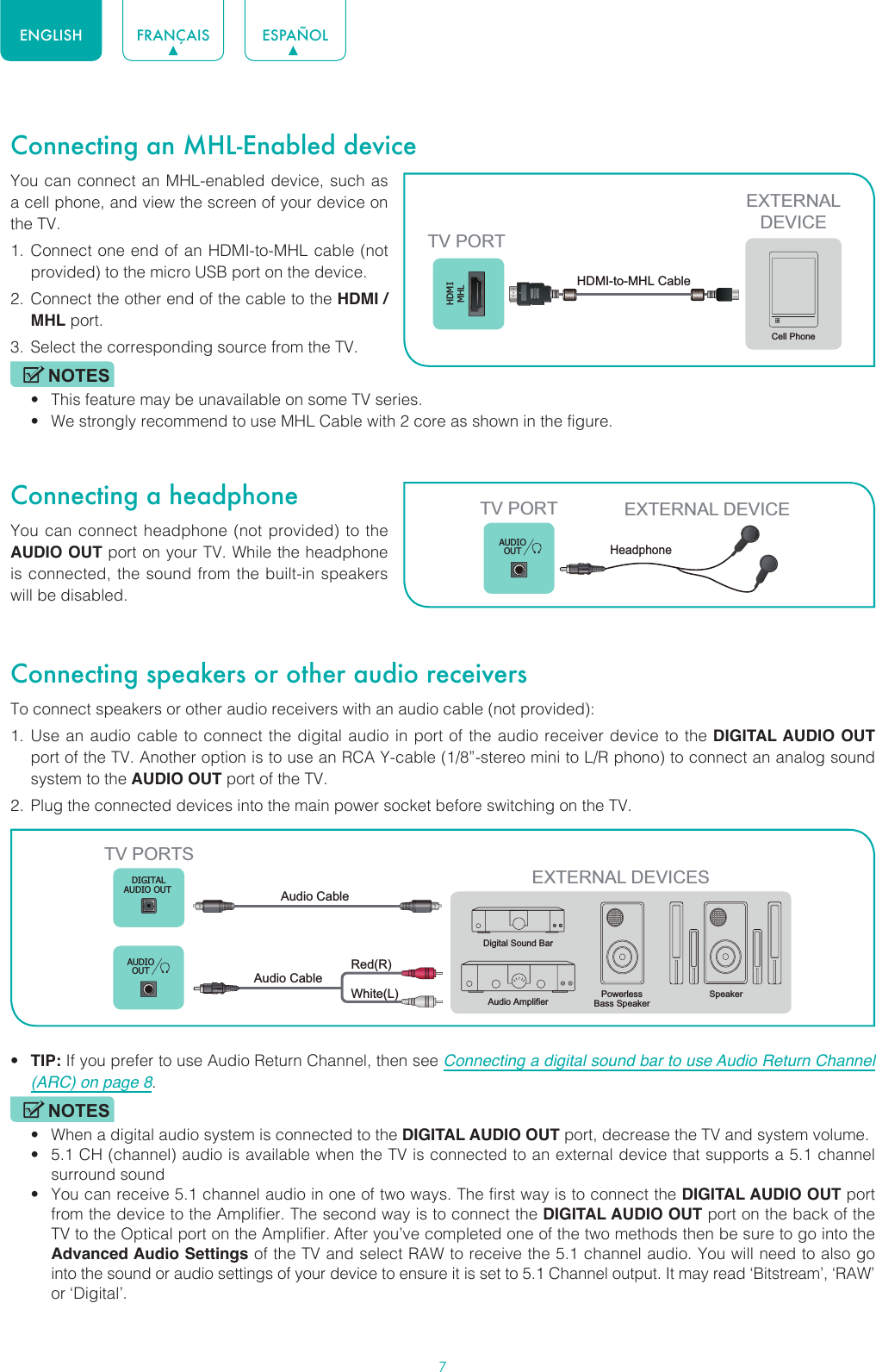
![8ENGLISH FRANÇAIS ESPAÑOLConnecting a digital sound bar to use Audio Return Channel (ARC)If you’d like to use the Audio Return Channel (ARC) feature to have sound sent from the TV back down an HDMI cable to a digital sound bar, then you will need to connect the cable to the HDMI / ARC port. By using this feature, you will also be able to control the sound bar with your TV remote instead of having to use multiple remotes for each device. To connect a digital sound bar with an HDMI cable (not provided):1. Connect the cable that’s attached to the sound bar to the HDMI / ARC port on the TV.2. Turn on the sound bar by pressing the Power button.3. Press the [ ] button on your remote and press the [ ˅ ] button of your remote to select Settings, then press [OK] to enter the Settings menu, go to System > CEC Function.4. Turn on the CEC Control setting.5. Turn on the Audio Receiver setting.NOTES• Only digital sound bars that require a wired connection are compatible with the TV.• If the device has an Input Selector feature then make sure to change it to TV.Connecting a USB deviceYou can connect the USB devices such as hard drives, USB sticks and digital cameras for browsing photos, listening music and watching recorded movies.1. Connect a USB device into the USB port.2. Select the Media type on the Media screen or Home screen. For more information, see Media on page 28. NOTES• When connecting a hard disk or a USB hub, always connect the mains adapter of the connected device to the power supply. Exceeding a total current consumption may result in damage. The USB1.1 and USB2.0 devices maximum current consumption are 500mA. The USB3.0 device maximum current consumption is 1A.• For individual non-standard high-capacity mobile hard disk, if it’s impulse current is greater than or equal 1A, it may cause TV-rebooting or self-locking. So the TV does not support it.• The USB port supports a voltage of 5V.HDMIARCHDMIEXTERNAL DEVICETV PORTHDMI Cable Digital Sound BarTV PORTS EXTERNAL DEVICEUSBDC 5V 1A(MAX)USBDC 5V 0.5A(MAX)](https://usermanual.wiki/Hisense-Electric/LCDF0096.TempConfidential-W9HLCDF0096-User-Manual-2/User-Guide-3279491-Page-10.png)
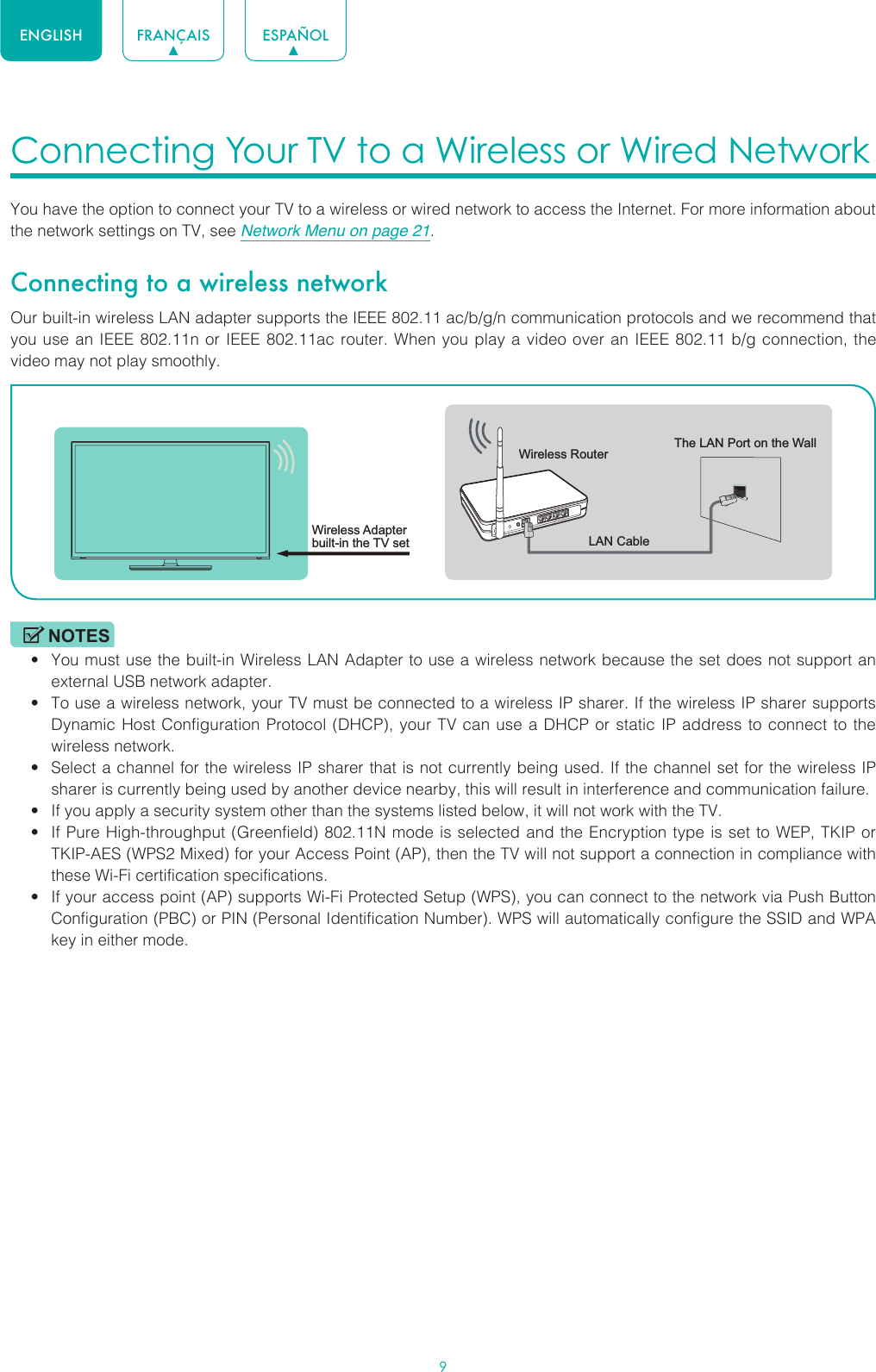
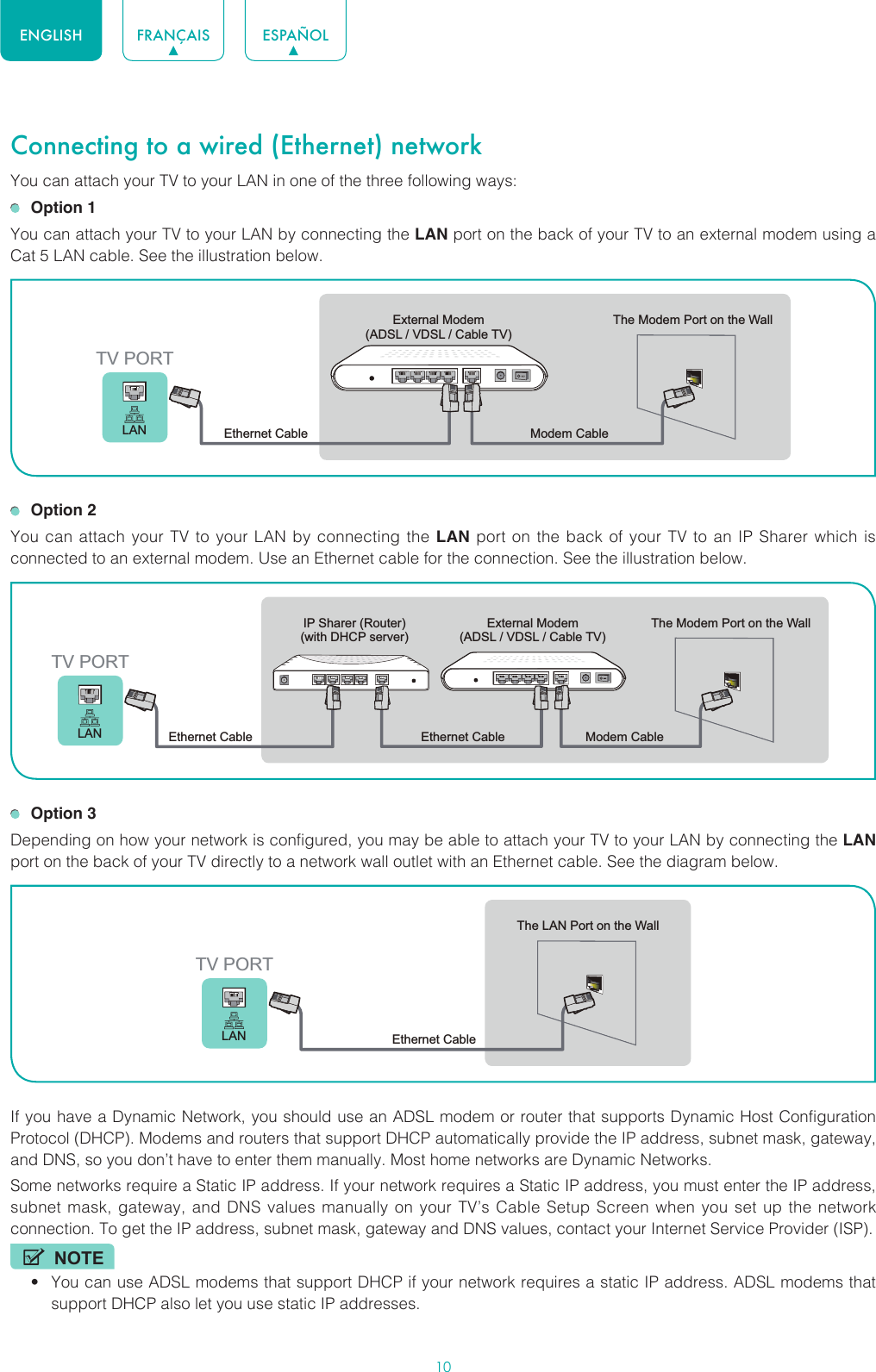
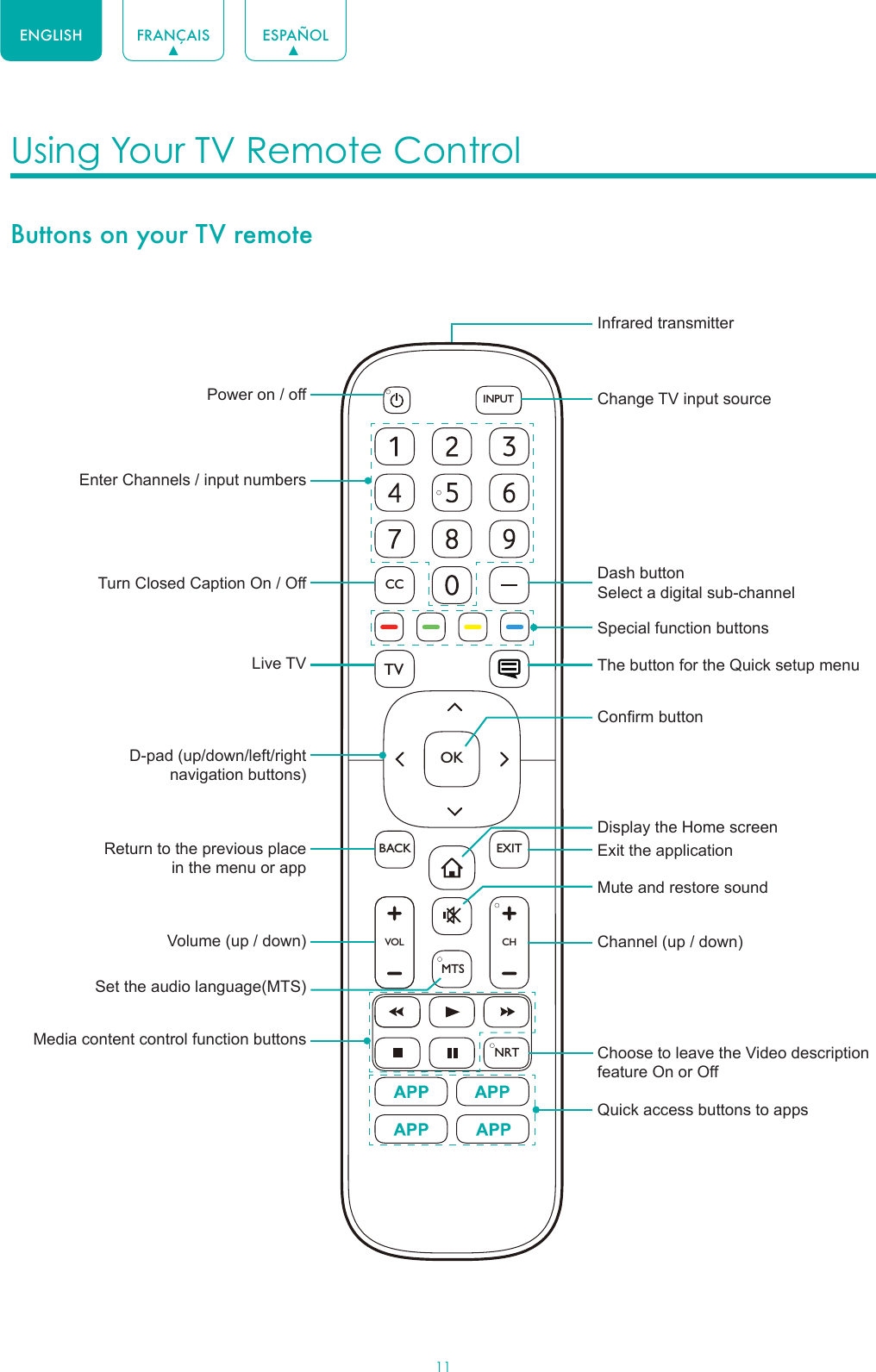
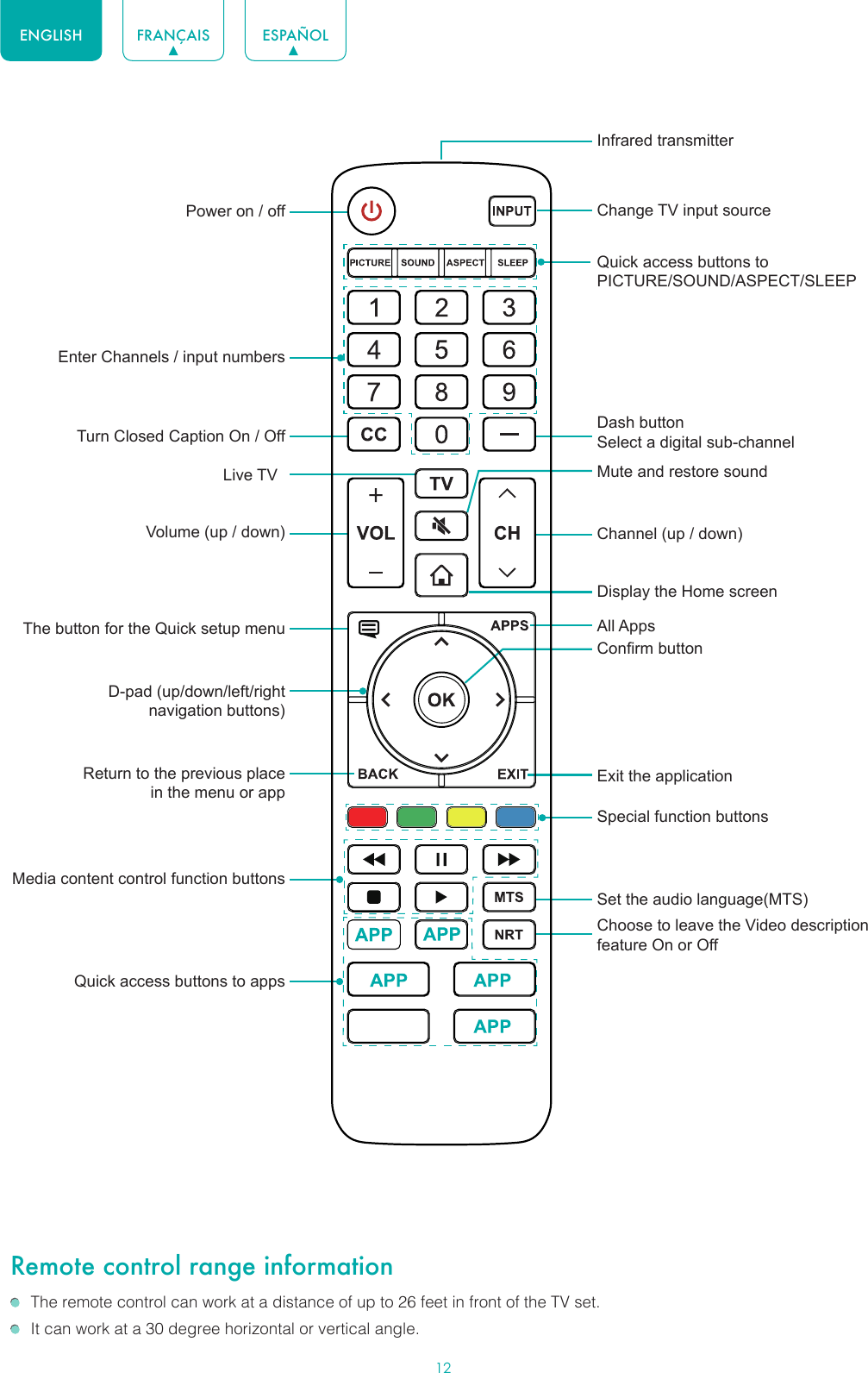
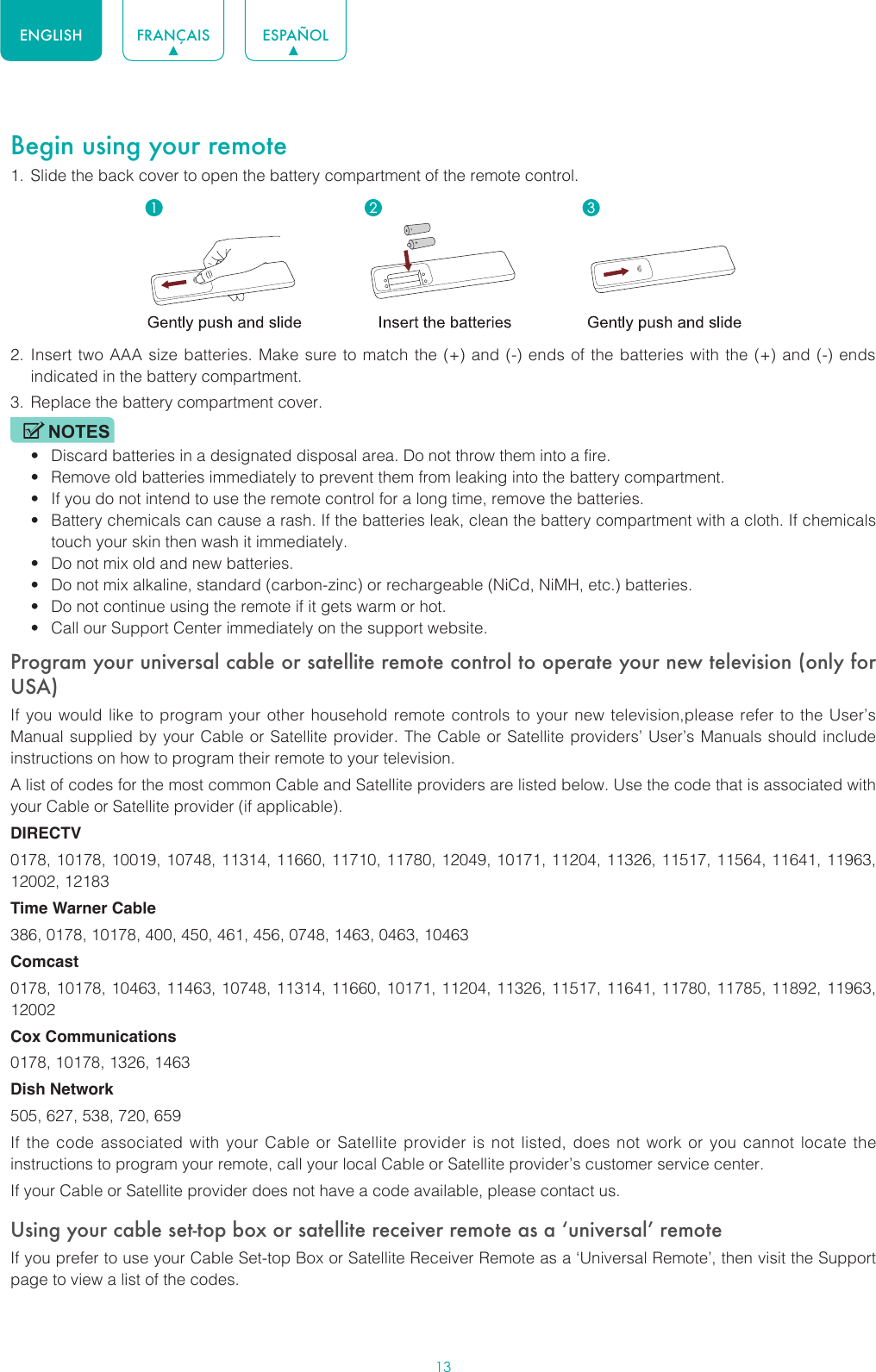
![14ENGLISH FRANÇAIS ESPAÑOLCompleting the First-Time Setup Menu Press the [ ]] button on the remote to turn on the TV. After the splash screen that displays the logo appears, begin the first-time setup menu.Screen TaskLanguage and Location Using the D-pad arrows of your remote, choose your Language, Country and Time Zone. End User License Agreement Choose Decline or Agree, then select Confirm icon and press [OK]. TV UsageSelect Home Mode(which appears by default).NOTE• Store Mode should only be selected by Retailers who plan to demonstrate the TV.Network ConnectionIf your TV does not automatically detect an Ethernet connection, then use a wireless network. Select your network from the list that displays, input the password. Also you can add a hidden network.Select your primary input sourceSelect how you receive your TV channels. Choose from one of the following sources below.• HDMI• ANT/CABLE• AV• COMPONENT• NONENOTE• If you use an antenna to receive channels, then you must complete the first-time setup menu in order to run a channel scan.](https://usermanual.wiki/Hisense-Electric/LCDF0096.TempConfidential-W9HLCDF0096-User-Manual-2/User-Guide-3279491-Page-16.png)
![15ENGLISH FRANÇAIS ESPAÑOLShortcuts Instructions You can use shortcuts on the remote control for fast operation. Turning your TV on or off To turn your TV on:1. Connect the power cord to the back of the TV, then plug the power cord into an AC outlet.2. When the TV is powered on, press the [ ] button on the remote to turn on TV. To turn your TV off, press the [ ] button on the remote.NOTES• When your TV is in standby mode, it is still consuming power. To completely disconnect power, please remove the plug from the AC outlet.• If your TV does not receive an input signal for several minutes, it automatically goes into standby mode.Selecting the input sourceSelect the Input Source depending on the video device you have connected to your TV.To select the input source:1. Turn on your TV, then press the [INPUT] button on the remote, the list of Source appears.2. Press the D-pad arrows of your remote to select the input source. 3. Press the [OK] button to confirm your selection.Using the Live TVTo view broadcast programs, press the [TV] button on your remote.Channel search guideWhen you select ANT/CABLE as input, if no TV channels were saved before, you will be prompted to do a channel search. You can also go to Setting menu > Channel to change the channel settings.Launch Live TVAfter channel tuning is done for the first time, the screen will display Live TV operating tips, including: how to load the channel list, how to Load info Bar and so on. [Menu] Load more functions[OK] Load Channel List[ v ] Load Info Bar[BACK] Load previous channel](https://usermanual.wiki/Hisense-Electric/LCDF0096.TempConfidential-W9HLCDF0096-User-Manual-2/User-Guide-3279491-Page-17.png)
![16ENGLISH FRANÇAIS ESPAÑOLViewing channel informationAs you use the [CH+ / CH-] button on your remote to scroll through channels, an information banner appears on the top of the screen.The information banner displays the following information:1. Channel number2. Lock status3. Input4. Program name5. Show identification6. Channel name7. Current date and time8. Beginning and end time of the next program9. Start/Stop time progress bar of the current program10. PromptIf you are watching a particular channel, you can also press the up arrow button of your remote to view channel information.Viewing a channel listAfter you have done an automatic channel scan (if you’re using an antenna) or are receiving your channels through a cable provider, you can view your list of channels by pressing [OK] on your remote.You will see the channel list display on the right side of the screen.Creating a Favorite ListTo quickly access your most-watched channels, you can create a Favorite List.To create your Favorite List:1. Press the [ ] button on your remote.2. Press the [ v ] button to select Settings, and then press [OK] button to enter the Settings menu.3. Select Channel > Favorite List.4. Using the [ v / v ] buttons of your remote, select a channel and press [OK] button.A heart-shaped indicator will appear beside the channel as confirmation that it has been successfully added.Viewing your Favorite listTo view channels that you’ve added to your Favorite List simply press [OK] on your remote to call out the channel list.The channel list appears on the right side of the screen and heart-shaped icons are shown next to the channels that make up your Favorites List. You can press [ < / > ] buttons to switch the channel list (Antenna or Cable) , Favorite and History list.6-30-2004 10:10 PMAntenna │ CC │TV-Y │DTV │ 16:9 │ 1080i │ Unknown 5.1CH7-1 1:00 AM - 7-1 4:00 AM AT06 1080iAT05 1080i6-30 10:00 PM 7-1 1:00 AM1672 3 4 58 9AT05-25-210](https://usermanual.wiki/Hisense-Electric/LCDF0096.TempConfidential-W9HLCDF0096-User-Manual-2/User-Guide-3279491-Page-18.png)
![17ENGLISH FRANÇAIS ESPAÑOLUsing the Menu FunctionTo quickly access menu function, press the [ ] button on your remote.Accessibility You can set Menu Audio, Video Description and High Contrast Menu on or off. The function can be used to meet the needs of visually impaired people.When the Menu Audio is set on, the contents of each menu display can be broadcast out.When the Video Description is set on, you can hear the introduction of relevant programs.When the High Contrast Menu is set on, the comparison of menu items is more vivid.Number PadYou can press digital keys on the left of the screen, to get the relevant channels easily.Picture ModeIf you’d like to configure the settings for your picture, then there are seven types of picture modes available: Vivid, Standard, Energy Saving, Movie, Game, Sport and Calibrated. Sound ModeSelect a preset sound mode to suit the type of content you are listening to: Standard, Theater, Music, Speech and Late Night.Aspect RatioAdjust the Aspect Ratio to stretch or zoom in on your picture. You can choose from the following settings: Auto, Normal, Zoom, Wide, Direct, Dot-By-Dot, Panoramic or Cinema.CC You can switch between CC Off, CC On and CC On When Mute.Audio Language(MTS)You can choose the audio language in DTV mode and you can set MTS for Mono, Stereo or SAP in ATV mode.Audio OnlyWhen you select this option, the screen will not display the picture. You can only listen the audio. Press any button except the [ ] button, Volume [+/-] buttons and [ ] button to restore operation.SettingsThe Settings Menu consists of the following settings: Picture, Sound, Network, Channel, Accessibility, System and Support.](https://usermanual.wiki/Hisense-Electric/LCDF0096.TempConfidential-W9HLCDF0096-User-Manual-2/User-Guide-3279491-Page-19.png)
![18ENGLISH FRANÇAIS ESPAÑOLBasic Settings Your TV comes with many TV setting features to allow you to customize the picture based on your viewing preference and environment. As you navigate throughout different screens to access settings, some of the indicators appear as words On and Off. Using the Settings MenuYou can press the [ ] button to access the Menu, press the [ v ] button on the D-pad to select Settings, and then press [OK] button to enter the Settings Menu.The Settings Menu consists of the following settings: • Picture• Sound• Network• Channel• Accessibility• System• SupportIn each menu, you can: Press the [ v / v ] buttons to select an item. Press the [OK] buttons to enter the sub-menu or to set on or off. Press the [ < / > ] buttons to adjust the value. Press the [BACK] button to return to the previous menu. Press the [EXIT] button to exit the menu.](https://usermanual.wiki/Hisense-Electric/LCDF0096.TempConfidential-W9HLCDF0096-User-Manual-2/User-Guide-3279491-Page-20.png)
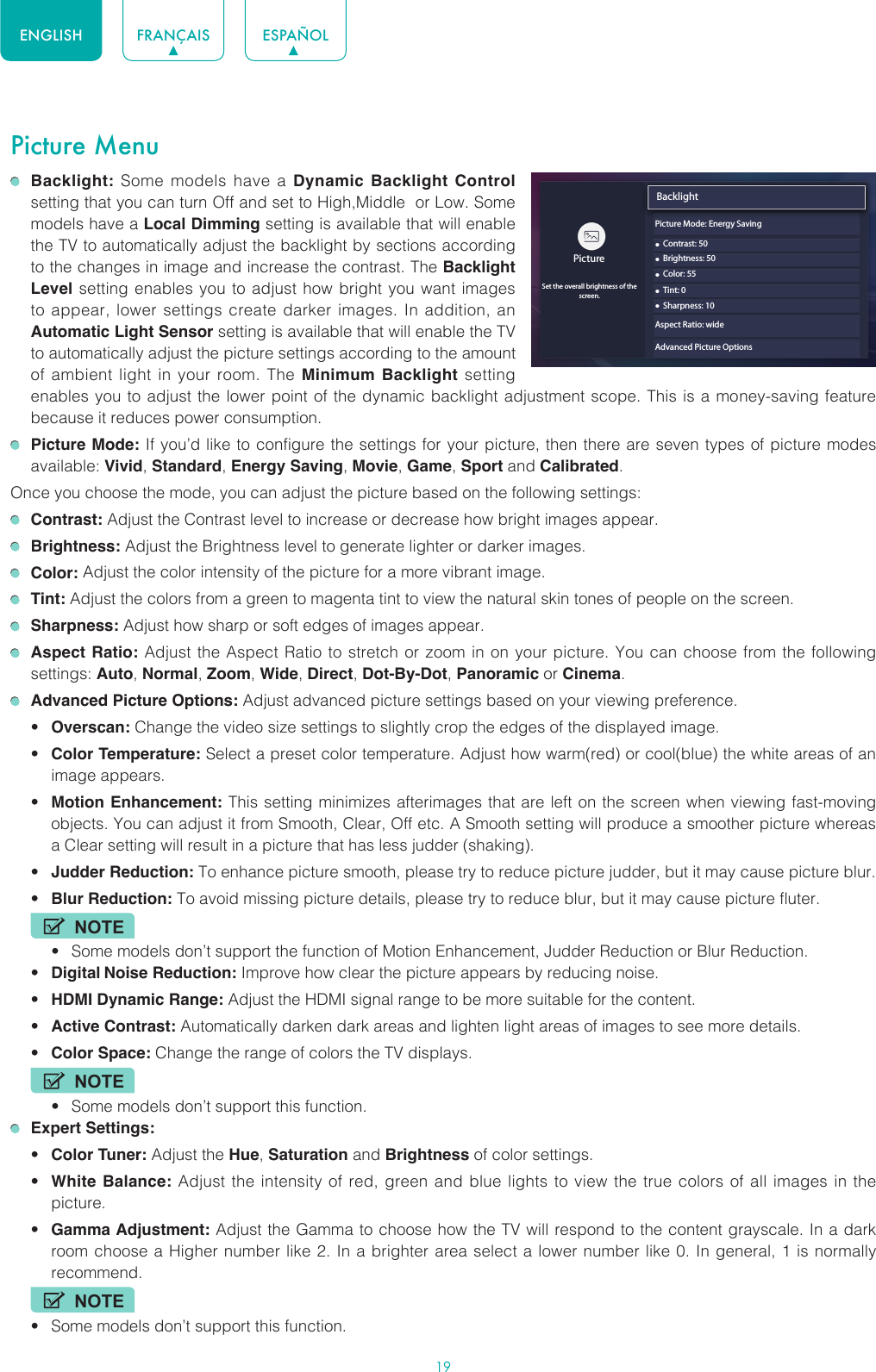
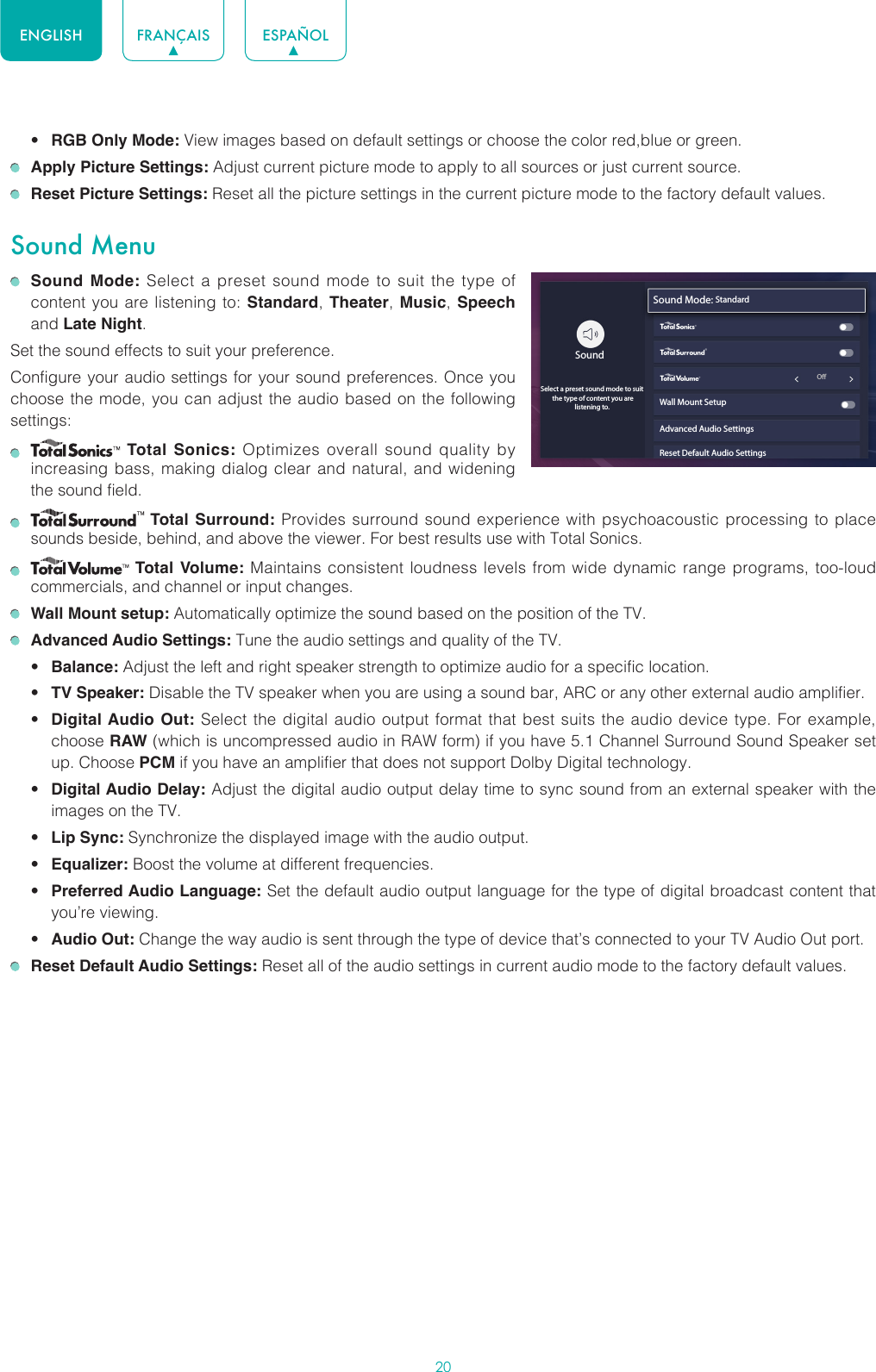
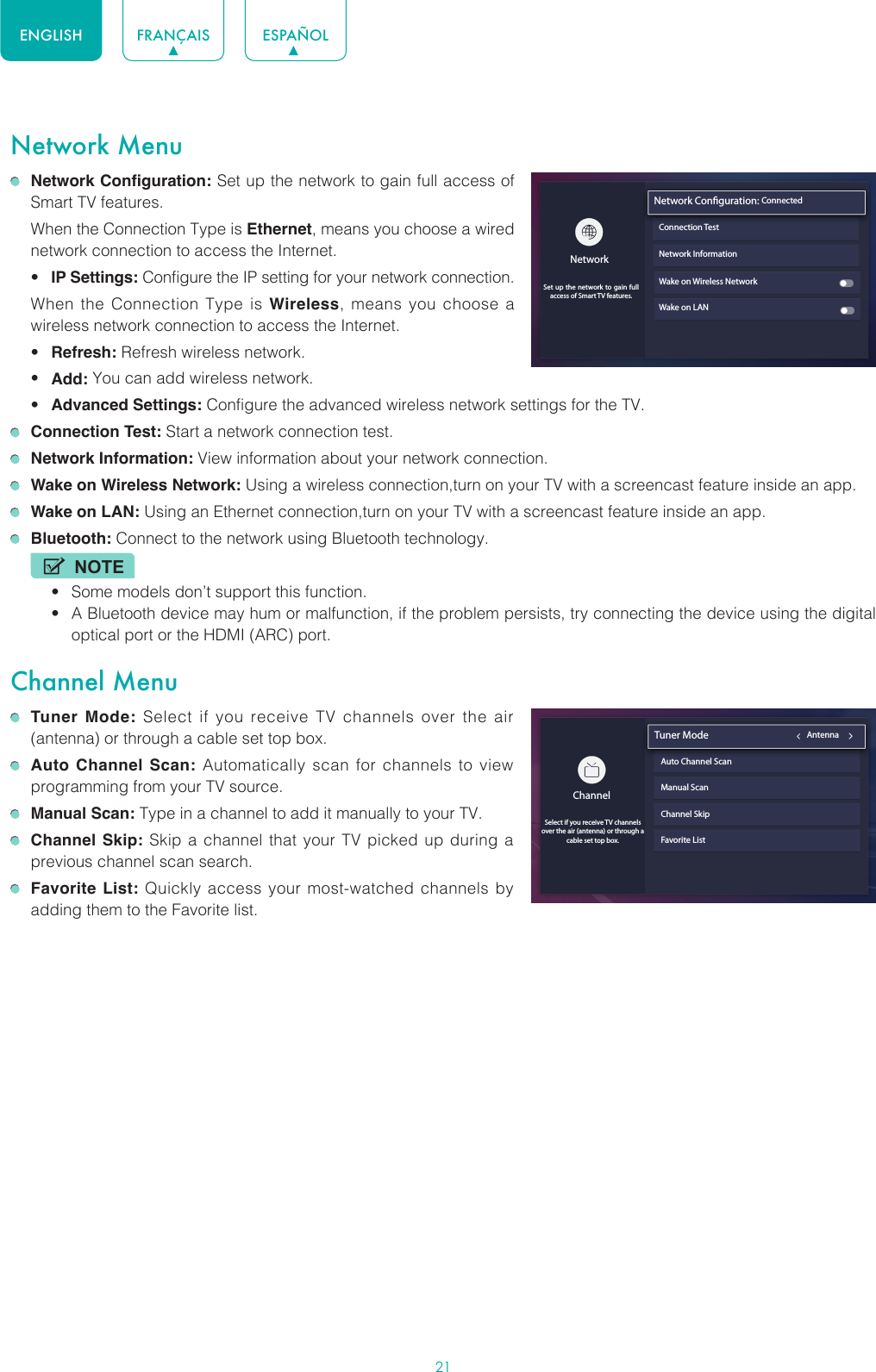
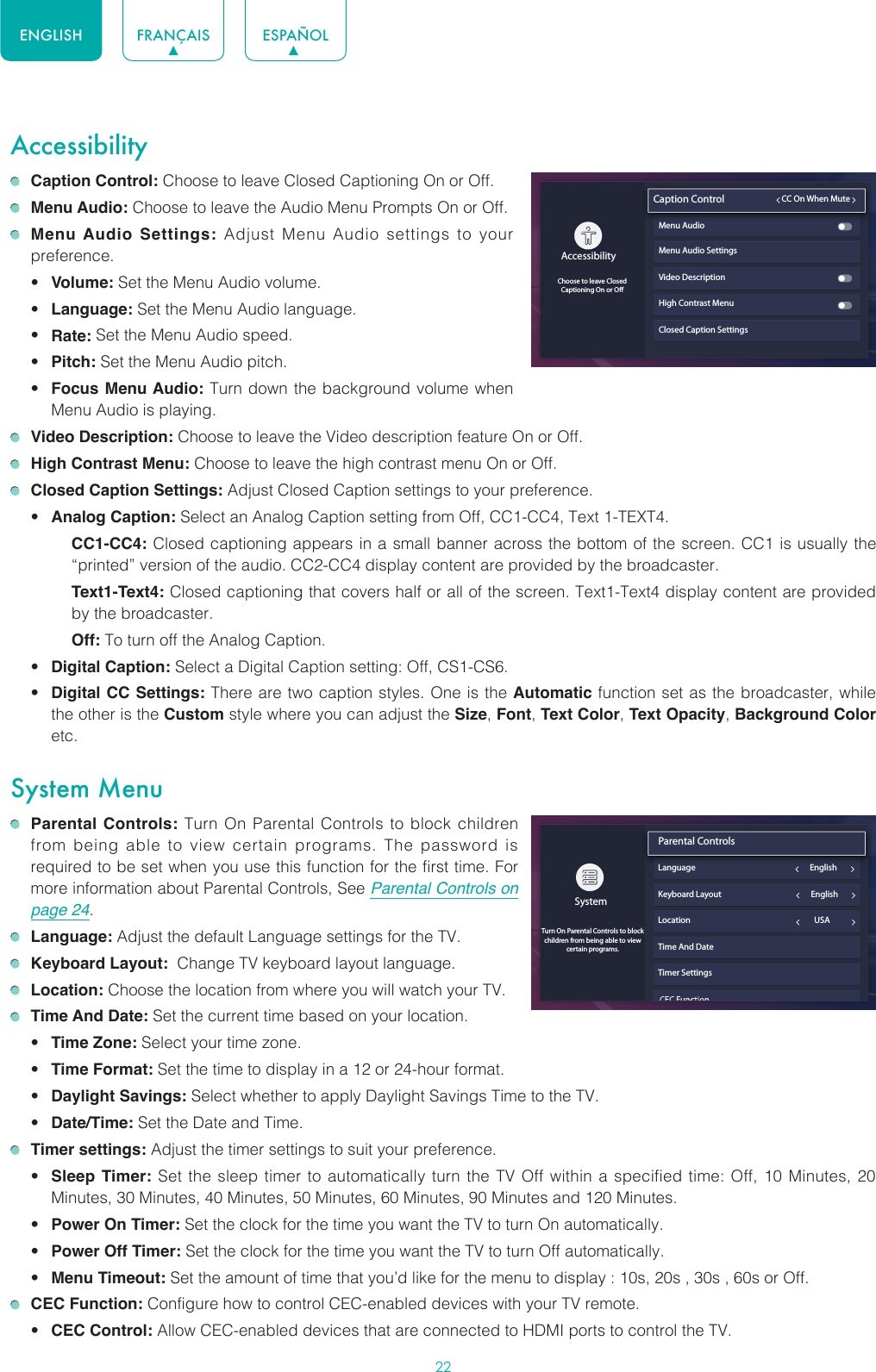
![23ENGLISH FRANÇAIS ESPAÑOL• Device Auto Power Off: Allow CEC-enabled devices to turn off with the TV.• TV Auto Power On: Allow the TV to turn On with CEC-enabled devices.• Audio Receiver: Allow the Audio Receiver to send audio over an HDMI cable and back to or from your TV.• CEC Device Lists: View a list of all CEC-enabled devices.• Device Connect: Allow connected devices to the HDMI ports to communicate back and forth with the TV.NOTES• HDMI cables must be used to connect HDMI CEC-compatible devices to your TV.• The HDMI CEC feature of the connected device must be turned on.• If you connect an HDMI device that is not HDMI CEC-compatible, all the HDMI-CEC Control features do not work.• Depending on the connected HDMI device, the HDMI-CEC Control feature may not work. HDMI 2.0 Format: Match the connected device output format. Select Enhanced for devices of 4K, 60Hz, 4:4:4:4:2:2 or 4:2:0, 10 bit and above. TV Name: Choose a name for your TV. The name will be shown to devices that are available for sharing data. Application Settings: Set settings for apps on your TV.• Anyview Stream: Share video, music or other content from compatible device on your TV screen.• Netflix: Remove this TV from your Netflix account. Please contact Netflix if you want to stop being billed for your service.• VUDU: Remove this TV from your VUDU account. Please contact VUDU if you want to stop being billed for your service. Advanced Settings: Access the Advanced Settings menu.• Power LED: Set the power indicator light to stay On or Off when standby mode.• Audio Only: Turn off the screen display to save energy. Press any button except the [ ] button, Volume [+/-] buttons and [ ] button to turn the picture back on.• Input Labels: Edit the input labels.• Default Live TV Source: Set up a source as the default source, which is launched with the Live TV button.• Screensaver: Select to show an active screensaver when the TV is idle.• Notifications: Allow pop-up notifications to appear for useful information and events that occur with your TV.• Send Diagnostics and Usage: Send TV running errors and usage statistics to the server to improve service quality (No personal information is collected).• Use Mode: Set the TV to use in Home or Store Mode (Some models have a Store Mode with 4K Video). Setup Wizard: Use the Setup Wizard for instructions to help you set up your TV.Support Menu About: View system information. Disclaimer: Click to read the Disclaimer details. Check Firmware Upgrade: Check to ensure that your TV has received the latest firmware. Signal Diagnosis: Check diagnostic information for current input source. Reset To Default: Reset your TV back to the factory default.Support](https://usermanual.wiki/Hisense-Electric/LCDF0096.TempConfidential-W9HLCDF0096-User-Manual-2/User-Guide-3279491-Page-25.png)
![24ENGLISH FRANÇAIS ESPAÑOLParental ControlsThe Parental Controls setting allows you to block content that is not appropriate for children to watch. You can do this by creating a 4-digit password.Turning Parental Controls On1. Press the [ ] button on your remote.2. Press the [ v ] button on the D-pad to select Settings, press [OK] button to enter the Settings menu.3. Select System > Parental Controls.4. Press the [OK] button on your remote, a Create PIN window displays. Using the numerical keypad on the window, create the password.5. Go to Locks.6. Press the [OK] button to turn the locks On. You will see the other Parental Control settings change from a greyed out state and become highlighted. When this occurs, begin adding other settings to the Block Time, Channel Block, Program Block, Input Block, App Restriction, Change PIN or Restore Parental Control Defaults features. Block Time: Block certain channels and programs during certain periods of time. Channel Block: Block programs by channels when you turn on the Parental Controls feature. Program Block: Certain programs are blocked when you activate the parental control settings. Input Block: Block content from devices that are connected to certain TV ports. App Restriction: Block specific apps when Parental Controls is on. Change PIN: Change your PIN that you use to access Parental Controls. If you want to change your parental control password, first enter the new password then enter the same password again.NOTE• If you forget your password, call the Consumer Electronics Care Center. Restore Parental Control Defaults: Reset Parental Controls back to the factory setting.Description of US TV RatingsContent Defined asAAllDSuggestive dialogLCoarse or crude languageSSexual situationsVViolenceFV Fantasy ViolenceDescription of Age-based RatingsAge Defined asTV-Y All childrenTV-Y7 Directed to older childrenTV-G General audienceTV-PG Parental Guidance SuggestedTV-14 Parents strongly cautionedTV-MA Mature Audiences OnlyUS Movie Ratings](https://usermanual.wiki/Hisense-Electric/LCDF0096.TempConfidential-W9HLCDF0096-User-Manual-2/User-Guide-3279491-Page-26.png)
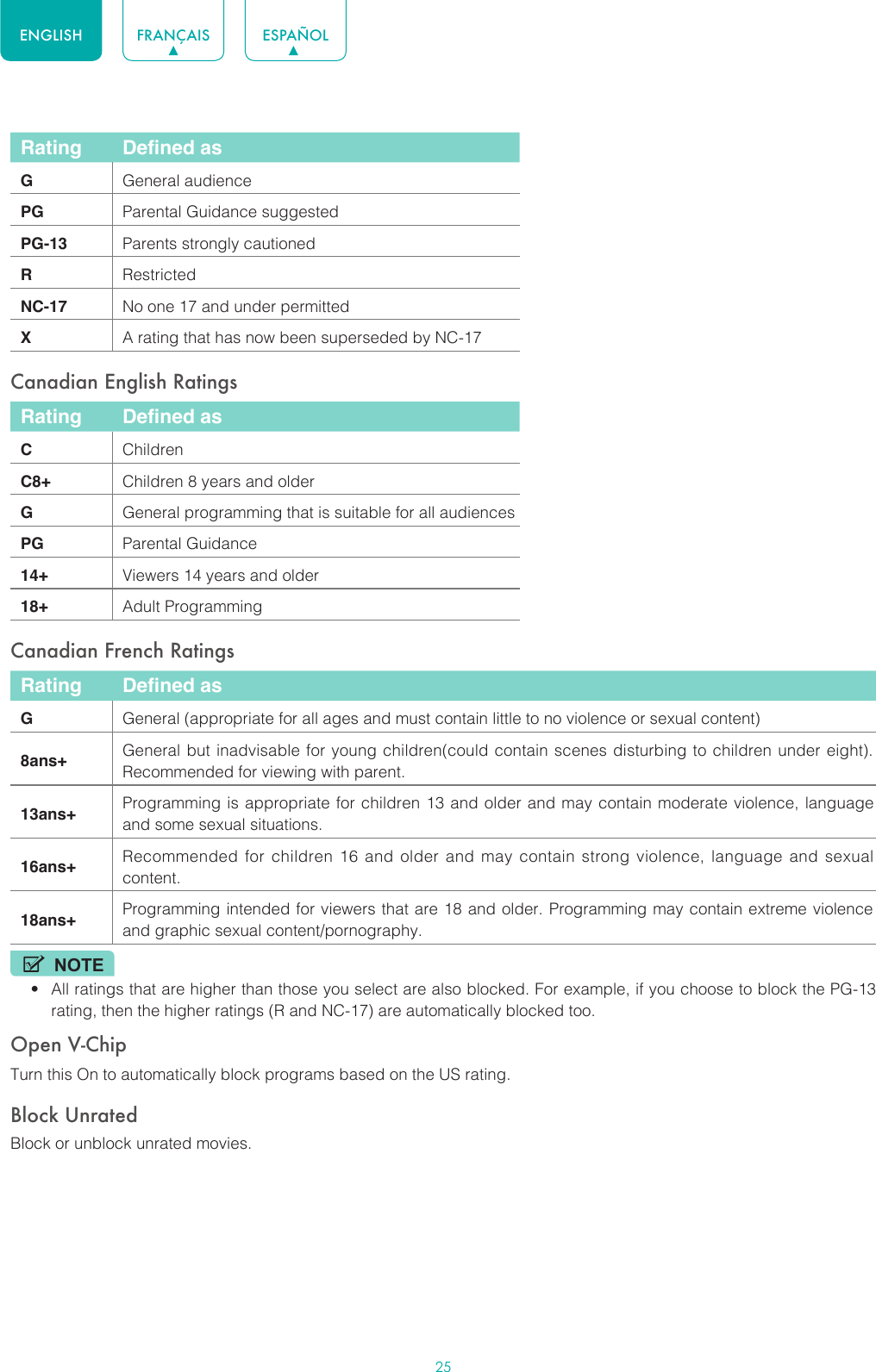
![26ENGLISH FRANÇAIS ESPAÑOLAdvanced TV Settings Getting familiar with the Home screenThe simple design of the Home screen menu makes it easy to navigate. It serves as the central location to access Notifications, All Apps, LiveTV, All Inputs, Media, Settings and Edit on the back of the TV that you’ve connected external devices to.To access the Home screen, press the [] button on your remote control and use the arrows on the D-pad to make your selection.Indicators and Icons on the top of the Home screenYou can always view the current time in the top left corner of the Home screen.If your TV is connected to the Internet through a wireless connection, then an icon will display in the top right corner of the screen. This location makes it very convenient for you to determine if you still have Internet connectivity as you use the TV. Names of sections that appear on the Home screenThe Home screen displays the following section names:• Notifications• All Apps• LiveTV• All Inputs• Media• Settings• EditNotificationsIf your TV is connected to an external device, the screen will be prompted.](https://usermanual.wiki/Hisense-Electric/LCDF0096.TempConfidential-W9HLCDF0096-User-Manual-2/User-Guide-3279491-Page-28.png)
![27ENGLISH FRANÇAIS ESPAÑOLAll AppsNumerous factory-installed apps are available for you to choose from for your entertainment preferences.Installing an App To install an app from the App Installer:1. From the Home screen, click on the All Apps to select the App Installer icon.2. Use the navigation buttons on your remote to select the app that you want to install.3. Press the [OK] button on your remote. To install an app from the Opera TV Store:Even though your TV has numerous factory-installed apps, there may be others that you’d like to download.1. From the Home screen, click on the All Apps to select the Opera TV Store icon.2. Navigate to the SEARCH tab.3. Begin typing the name of the app. As you begin typing the first two to three letters the Opera Store suggests words to quicken your search time.4. Use the navigation buttons of your remote to select the app. A page displays that shows a written description of the app.5. Click on OPEN or ADD TO FAVORITES.Removing an AppYou can only delete apps that you’ve installed to the TV. Factory-installed apps can not be deleted.To delete an app:1. From the All Apps screen, click on the Delete icon.2. Use the navigation buttons on your remote to select the app that you want to remove. 3. Press the [OK] button on your remote. A dialog message displays that asks if you’re sure you want to remove the app.4. Click on Delete. A confirmation message displays and the icon is removed from the Apps list screen.NOTE• If an app is deleted,the information related to that app is also removed.Moving App Icons aroundApps can not be moved around on the screen.Customizing the name of your TVIf you have several TV’s in your home then you may want to customize the name of your TV. By giving your TV a name, it will make it easier for you to identify it when connecting devices to the TV to stream or mirror content.To customize the name of your TV: 1. Press the [ ] button on your remote.2. Press the [ v ] button on the D-pad to select Settings, press [OK] button to enter the Settings menu.3. Go to System > TV Name.4. Select User Input to bring up the keyboard and begin typing the name.5. When you are finished, power off the TV and power it back on for the change to take effect.](https://usermanual.wiki/Hisense-Electric/LCDF0096.TempConfidential-W9HLCDF0096-User-Manual-2/User-Guide-3279491-Page-29.png)
![28ENGLISH FRANÇAIS ESPAÑOLMediaMedia is a central location for you to view or listen to different types of content (for example, your photos, music and movies) through the following methods:• A USB thumb drive or hard drive• Compatible mobile phone, tablet or other personal device: You can stream movies, music and photos that are stored on Compatible personal device and play or view the content on your TV.Panels that appear on the Media screenThe Media screen displays four panels: Picture, Video, Music and All.File formats that may be supportedNOTE• Due to differences in programming tools and other factors, some of the file formats that are listed may or may not be supported.Medium File FormatVideo .avi (MPEG2, Divx), .mkv (Divx), .mpeg (MPEG2), .wmv (Divx, XviD)Picture .JPGMusic .mp3Browsing ContentTo browse through content based on the type that you wish to access:1. Navigate to the appropriate menu tab on the left side of the screen and select Music, Video, Picture or All. 2. Click on the name of the folder that contains your content.3. Make your selection to play or view the content.If you want to close out of the Media center, then press the [EXIT] button on your remote.Viewing Pictures as a SlideshowTo view pictures in a slideshow:1. Navigate to the Picture tab.2. Click on start the Slideshow.The slideshow of your pictures begins to play. To stop the slideshow, press the [OK] button on your remote and press it again to restart it.Viewing VideoWhile viewing video you will see a number of icons appear at the bottom of the screen. You can use the navigation buttons of your remote to select these icons that will control the video.EditBy operating this option, you can edit the home page, add a title, add an input, add an app and add a channel. Using the [ v / v ] buttons of your remote to change or remove it, also you can select Reset to return your operation.](https://usermanual.wiki/Hisense-Electric/LCDF0096.TempConfidential-W9HLCDF0096-User-Manual-2/User-Guide-3279491-Page-30.png)
![29ENGLISH FRANÇAIS ESPAÑOLUsing Anyview Cast to mirror content from your device to the TV screenThe Anyview Cast is an app that enables you to share (or cast) a video, audio or image from your Android-based device to the TV.From your tablet or phoneTo mirror content from your tablet or phone to the TV:1. Press the [ ] button on your remote, press the [ v ] button on the D-pad to select Settings, press [OK] button to enter the Settings menu. Go to Network > Network Configuration and select Wireless.2. Press the [ INPUT ] button on your remote and select the Anyview Cast. 3. Turn on the wireless display function on your Android-based device.NOTE• Some Android-based devices may not support casting.4. Find your TV in the list of devices that displays and select it.5. Wait for the Creating Connection progress bar to complete on the TV screen and the video or image will display in a moment.](https://usermanual.wiki/Hisense-Electric/LCDF0096.TempConfidential-W9HLCDF0096-User-Manual-2/User-Guide-3279491-Page-31.png)
![30ENGLISH FRANÇAIS ESPAÑOLSoftware updates for your TVThe software (also referred to as firmware) is part of what powers your TV. We will provide software updates to continuously enhance your TV and correct any issues that may impact your user experience; therefore, we recommend that you keep your TV connected to the Internet to receive updates when they are available.You can choose to receive updates manually or check for software updates and install them manually.Checking for the latest firmwareTo manually check for the latest firmware:1. Using your remote, press the [ ] button.2. Press the [ v ] button on the D-pad to select Settings, press [OK] button to enter the Settings menu.3. Go to Support > Check Firmware Upgrade.](https://usermanual.wiki/Hisense-Electric/LCDF0096.TempConfidential-W9HLCDF0096-User-Manual-2/User-Guide-3279491-Page-32.png)
![31ENGLISH FRANÇAIS ESPAÑOLQuick Problem-Solving Tips When you experience an issue with your TV, turn it off and on again. If this does not resolve the problem, then refer to the tips below. If the problem is still not resolved, then contact us. ISSUES POSSIBLE SOLUTIONSNo sound or picture• Check if the power cord is plugged into a powered AC outlet.• Press the [ ] button on the remote control to activate the unit from ‘Standby’ mode.• Check to see if the LED light is on or not. If it is, then the TV is receiving power.I have connected an external source to my TV and I get no picture and/or sound• Check for the correct output connection on the external source and for the correct input connection on the TV.• Make sure you have made the correct selection for the input mode for the incoming signal.When I turn on my TV, there is a delay for a few seconds before the picture appears. Is this normal?• Yes, this is normal. The TV is initializing and searching for previous setting information.The picture is normal but there is no sound• Check the volume settings.• Check if ‘Mute’ mode is set to On.Sound but no picture or black and white picture• If the picture is black and white, unplug the TV from the AC outlet and replug it after 60 seconds.• Check that the Color is set to 50 or higher. • Try different TV channels.The sound and/or picture is distorted or appears wavy• An electric appliance may be affecting the TV. Turn off any appliances that are nearby and move it farther away from the TV.• Insert the power plug of the TV set into another power outlet.The sound and picture is blurry or cuts out• If using an external antenna, check the direction, position and connection of the antenna.• Adjust the direction of your antenna or reset or fine tune the channel.A horizontal or vertical stripe appears on the picture and/or the picture is shaking• Check if there is an appliance or electric tool nearby that is causing interference.The plastic cabinet makes a “clicking” type of sound• The ‘click’ sound can occur when the temperature of the television changes. This change causes the television cabinet to expand or contract, which makes the sound. This is normal and the TV is OK.The remote control does not work• Confirm that TV still has power and is operational.• Change the batteries in the remote control.• Check if the batteries are correctly installed.NOTE• For usage in Mexico , operation of this equipment is subject to the following two conditions : 1 ) it is possible that this device doesn’t cause any detrimental interference and 2 ) this device must take any kind of interference, including that which may cause its malfunctioning.](https://usermanual.wiki/Hisense-Electric/LCDF0096.TempConfidential-W9HLCDF0096-User-Manual-2/User-Guide-3279491-Page-33.png)